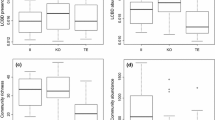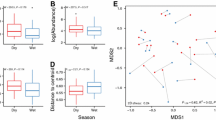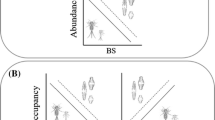Abstract
An understanding of the distribution patterns of organisms and the underlying factors is a fundamental goal of ecology. One commonly applied approach to visualize these is the analysis of occupancy-frequency patterns. We used data sets describing stream insect distributions from different regions of North America to analyze occupancy-frequency patterns and assess the effects of spatial scale, sampling intensity, and taxonomic resolution on these patterns. Distributions were dominated by satellite taxa (those occurring in ≤10% of sites), whereas the occurrence of core taxa (occurring in ≥90% of sites) determined the overall modality of occupancy-frequency patterns. The proportions of satellite taxa increased with spatial scale and showed positive relationships with sampling intensity (r 2=0.74–0.96). Furthermore, analyses of data sets from New York (USA) showed that generic-level assessments underestimated the satellite class and occasionally shifted occupancy-frequency distributions from unimodal to bimodal. Our results indicate that, regardless of species- or generic-level taxonomy, stream insect communities are characterized by satellite species and that the proportion of satellite species increases with spatial scale and sampling intensity. Thus, niche-based models of occupancy-frequency patterns better characterize stream insect communities than metapopulation models such as the core-satellite species hypothesis.


Similar content being viewed by others
References
Bock CE, Ricklefs RE (1983) Range size and local abundance of some North American songbirds: a positive correlation. Am Nat 122:295–299
Bossuyt B, Honnay O, Hermy M (2004) Scale-dependent frequency distributions of plant species in dune slacks: dispersal and niche limitation. J Veg Sci 15:323–330
Brown JH (1984) On the relationship between abundance and distribution in species. Am Nat 124:255–279
Cardinale BJ, Hillebrand H, Charles DF (2006) Geographic patterns of diversity in streams are predicted by a multivariate model of disturbance and productivity. J Ecol 94:609–618
Collins SL, Glenn SM (1991) Importance of spatial and temporal dynamics in species regional abundance and distribution. Ecology 72:654–664
Collins SL, Glenn SM (1997) Effects of organismal and distance scaling on analysis of species distribution and abundance. Ecol Appl 7:543–551
Connell JH (1978) Diversity in tropical rain forests and coral reefs. Science 199:1302–1310
Dodds WK, Gido K, Whiles M, Fritz K, Mathews W (2004) Life on the edge: ecology of Great Plains prairie streams. Bioscience 54:207–281
Gaston KJ, Blackburn TM (2000) Pattern and process in macroecology. Blackwell, London
Gaston KJ, Lawton JH (1989) Insect herbivores on bracken do not support the core-satellite species hypothesis. Am Nat 134:761–777
Gibson DJ, Ely JS, Collins SL (1999) The core-satellite species hypothesis provides a theoretical basis for Grime’s classification of dominant, subordinate, and transient species. J Ecol 87:1064–1067
Gibson DJ, Middleton BA, Foster K, Honu YAK, Hoyer EW, Mathis M (2005) Species frequency dynamics in an old-field succession: effects of disturbance, fertilizer, and scale. J Veg Sci 16:415–422
Gotelli NJ (1991) Metapopulation models: the rescue effect, the propagule rain and the core-satellite hypothesis. Am Nat 138:768–776
Gotelli NJ, Simberloff D (1987) The distribution and abundance of tallgrass prairie plants: a test of the Core-Satellite Species hypothesis. Am Nat 130:18–35
Hanski I (1982) Dynamics of regional distribution: the core and satellite species hypothesis. Oikos 38:210–221
Hanski I (1994) A practical model of metapopulation dynamics. J Anim Ecol 63:151–162
Hanski I, Gyllenberg M (1993) Two general metapopulation models and the core-satellite species hypothesis. Am Nat 142:17–41
Heino J (2005) Positive relationship between regional distribution and local abundance in stream insects: a consequence of niche breadth or niche position? Ecography 28:345–354
Huston M (1979) A general hypothesis of species diversity. Am Nat 113:81–101
Huryn AD, Slavik KA, Lowe RL, Parker SM, Anderson DS, Peterson BJ (2005) Landscape heterogeneity and the biodiversity of Arctic stream communities: a habitat template analysis. Can J Fish Aquat Sci 62:1905–1919
Levins R (1969) Some demographic and genetic consequences of environmental heterogeneity for biological control. Bull Entomol Soc Am 15:237–240
Malmqvist B, Zhang, Alder PH (1999) Diversity, distribution and larval habitats of North Swedish blackflies (Diptera: Simuliidae). Freshw Biol 42:301–314
McGeoch MA, Gaston KJ (2002) Occupancy-frequency distributions: patterns, artefacts, and mechanisms. Biol Rev 77:311–331
McNaughton SJ, Wolf LL (1970) Dominance and the niche in ecological systems. Science 167:131–139
Mehranvar L, Jackson DA (2001) History and taxonomy: their roles in the core-satellite species hypothesis. Oecologia 127:131–142
Moglen G, Nelson K, Palmer MA, Pizzuto JE, Rogers CE, Hejazi MI (2004) Hydro-ecological responses to land use in small urbanizing watersheds within the Chesapeake Bay Watershed. In: DeFries R, Asner G, Houghton R (eds) Ecosystems and land use change interactions. Geophysical Monograph Series, vol. 153, pp 41–60. American Geophysical Union, Washington D.C.
Moore AM, Palmer MA (2005) Agricultural watersheds in urbanizing landscapes: implications for conservation of biodiversity of stream invertebrates. Ecol Appl 15:1169–1177
Nee S, Gregory RD, May RM (1991) Core and satellite species: theory and artefacts. Oikos 62:83–87
Novotny V, Drozd P (2001) Sampling error can cause false rejection of the core-satellite species hypothesis. Oecologia 126:360–362
Perelman SB, León RJ, Oesterheld M (2001) Cross-scale vegetation patterns of Flooding Pampa grasslands. J Ecol 89:562–577
Raunkiaer C (1918) Recherches statistiques sur les formations végétales. Det Kgl Danske Vidensk. Selsk Biol Medd 1:3–80
Raunkiaer C (1934) The life-forms of plants and statistical plant geography. Oxford University Press, Oxford, pp 632
Reice SR, Wissmar RC, Naiman RJ (1990) Disturbance regimes, resilience, and recovery of animal communities and habitats in lotic ecosystems. Environ Manage 14:647–659
Resh VH, Brown AV, Covich AP, Gurtz ME, Li HW, Minshall W, Reice SR, Sheldon AL, Wallace JB, Wissmar RC (1988) The role of disturbance in stream ecology. J North Am Benthol Soc 7:433–455
Sale PF (1988) Perception, pattern, chance and the structure of reef fish communities. Environ Biol Fish 21:3–15
Sherry TW, Holmes RT (1988) Habitat selection by breeding American Redstarts in response to a dominant competitor, the Least Flycatcher. Auk 105:789–799
Storch D, Šizling AL (2002) Patterns of commonness and rarity in central European birds: reliability of the core-satellite hypothesis within a large scale. Ecography 25:405–416
Tokeshi M (1992) Dynamics of distribution in animal communities: theory and analysis. Res Popul Ecol 34:249–273
Townsend CR, Scarsbrook MR, Doledec S (1997) The intermediate disturbance hypothesis, refugia, and biodiversity in streams. Limnol Oceanogr 42:938–949
Ulrich W, Zalewski M (2006) Abundance and co-occurrence patterns of core and satellite species of ground beetles on small lake islands. Oikos 114: 338-348
van Rensburg BJ, McGeoch MA, Matthews W, Chown SL, van Jaarsveld AS (2000) Testing generalities in the shape of patch occupancy frequency distributions. Ecology 81:3163–3177
Wallace JB (1990) Recovery of lotic macroinvertebrate communities from disturbance. Environ Manage 14:605–620
Whittaker RH, Niering WA (1965) Vegetation of the Santa Catalina mountains, Arizona: a gradient analysis of the south slope. Ecology 46:429–452
Williams CB (1964) Patterns in the balance of nature. Academic, New York
Acknowledgements
Support for this research was provided by the National Science Foundation LTER Network Office. Tokeshi’s tests were performed using spreadsheets kindly provided by B. Bossuyt. Stream invertebrate sampling in Maryland was supported by an EPA STAR grant ®-82801201). The New York data set was collected as part of a Safe Drinking Water project funded by New York State Department of Environmental Conservation and the United States Environmental Protection Agency. The comments of Suzanne Stapleton and two anonymous reviewers greatly improved the quality of the manuscript.
Author information
Authors and Affiliations
Corresponding author
Additional information
Communicated by Andrew Gonzales.
Electronic supplementary material
Rights and permissions
About this article
Cite this article
Heatherly, T., Whiles, M.R., Gibson, D.J. et al. Stream insect occupancy-frequency patterns and metapopulation structure. Oecologia 151, 313–321 (2007). https://doi.org/10.1007/s00442-006-0596-8
Received:
Accepted:
Published:
Issue Date:
DOI: https://doi.org/10.1007/s00442-006-0596-8




